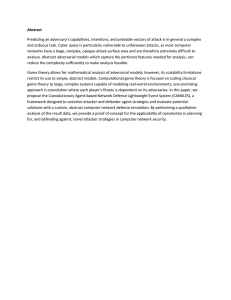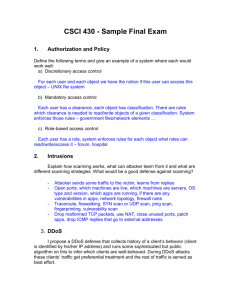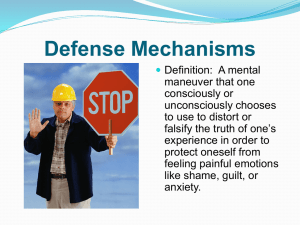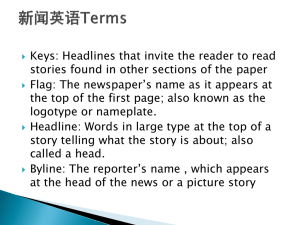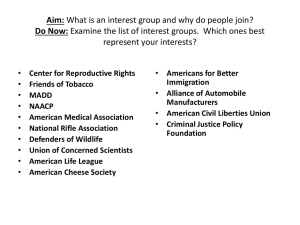Self Defense Power Point 06
advertisement
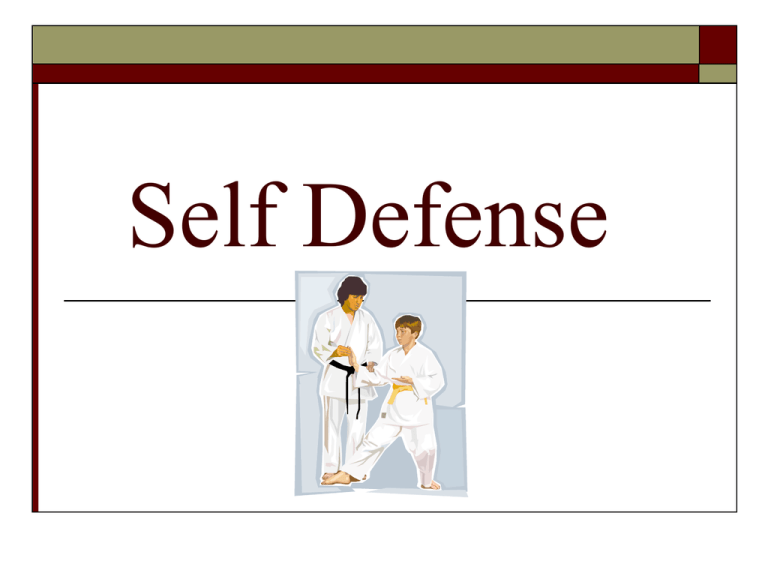
Self Defense Definition of Self Defense: -the act of defending oneself or something that belongs or relates to oneself. There might be a time that you might have to attack in order to stop an attack, but only attack in self defense of yourself or others Types of Criminals Professionals Predators Want your valuables and they don’t care if they abuse, injure or humiliate their victims Postures Plan their crimes to avoid confrontation and usually are not a physical threat unless they are provoked They are dangerous in the fact that they may do things that are much more dangerous than the situation demands Psychos Most dangerous criminal. They do not have any sane motivation for their violence and they are totally unpredictable. Self Defense Situations Three basic types 1. Control • • • • Someone not making threats at that moment but they are unruly or trespassing They are causing a problem or they are refusing to leave The person must be controlled and/or removed Techniques cause pain but not injury while protecting you from retaliation Self Defense Situations cont. Defense against an attack 2. • • Someone is attacking you to rob you or they just enjoy fighting Techniques must be powerful and effective – may cause serious injury or death Defense of Life 3. • • • Someone is trying to seriously injure you or kill you – you are fighting for your life Techniques are powerful, effective and possibly deadly with no moral, civil or legal consideration To any witness, your actions were necessary to protect your life Anger and a Killer Instinct DO NOT USE ANGER IN SELF DEFENSE!!! It will only rob you of control, power and speed. Because you will not be thinking clearly and your body will be tense. You must be prepared to fight as if your life depended on it. The overpowering desire to do whatever it takes to survive is what self defense is really about. Confrontations 1. 2. 3. 4. 5. 6. 7. 8. Discussions Disagreements (verbal or written) Arguments (verbal or written) Lawsuits Police assistance required Unarmed fistfights Armed attacks Life or death struggle (armed or unarmed) Awareness Surroundings Know the area or establishment that you are going to How are you going to escape Keep your back to a wall so it is protected Clothing Is your clothing appropriate for that destination? Is it offensive to others? Is it too baggy? Is it too tight? Are your shoe soles slick or sticky? Do they limit your kicks? Are you wearing a belt? Can you use it? Do Not Neglect the Obvious Long Hair – easy to grab, excellent handles High Heels – bad for running, good for kicking or stomping Clothes Jewelry – may hamper your defense. Necklaces, chains, pierced ears, nose, etc. Rings may help during strikes. Hampered arms – holding packages, child, etc. Confident, Non Aggressive Movement Eyes – keep them forward and scanning Head – held high, confident Shoulders – natural posture, not slouched Hands – keep them free and in front of you Abdomen – slightly flexed, keep spine straight Legs – straight without being locked Feet – lead foot about half step in front of the other foot Defensive Stance Step back with your strong side away from the attacker Raise your hands open to your face level and tell the person to stop Act passive but be prepared to block an attack and then counter attack with authority DO NOT ASSUME A FIGHTING STANCE! It give the attacker a warning of what you might do to defend yourself. Intimidation and Expressions Intimidation may be worse than the attack itself Do not be intimidated, force the situation on your terms Express your emotions in a self defense situation. You can use real emotions or a false emotion to confuse your attacker. Types of emotion – confidence, friendly, solemn, unconcerned contempt, shock, fear and anger. Fighting FIGHT ON YOUR OWN TERMS!!! Not on our attackers. Position yourself so your back is to the sun and in your opponents eyes. Stay in control of the fight. You might get hit, but you are in control of the situation. Do not give your intentions away on how you may fight. Keep your arms free to move. Once the fight begins, anything goes. Guarding ALWAYS KEEP YOUR GUARD UP!!! Even when you punch, kick, block or move. Never leave an opening. Blocking Areas High Middle Low Left Right Strikes Eyes and throat for your lead hand Use fingernails Palm heel strike to chin Solar plexus and ribs for the trailing hand This will take the wind out of your attacker and may cause them to collapse Groin Knee Instep of their lead leg for a stomp kick Head butt Elbow strikes to face or ribs Strikes cont. Things not to do High kicks Grabbing your opponent Off balance They can get their hands on you now Fall to the ground Rocks, glass, their friends Dealing with Law Enforcement Notify authorities as soon as possible Cooperate with law enforcement officers Be polite Be careful of apologizing or saying that your are sorry May imply guilt Windows of Opportunity Many different ways that an attacker can be distracted or made to hesitate and that will give you a window of opportunity. Some internal factors that influence an attacker: Over-confidence Too relaxed Thinking about the attack Mustering up courage Having second thoughts Being conscious of others, cameras, security equipment, escape routes, etc Rules or no Rules Do what it takes to get yourself out of a situation. Remember, you are responsible for your actions, even while being attacked. Three approaches to Self Defense Training 1. 2. 3. Reaction based approach – if the attacker does “A” the defender reacts with technique “B” Reflex based approach – the defender reflexively responds to an attack with whatever technique seems appropriate at the time Response based approach – instead of attempting a specific technique to an attack, you take what the attacker gives you and you improvise ONE LAST THING GET OUT OF THERE AS SOON AS YOU CAN – RUN AWAY!!!
